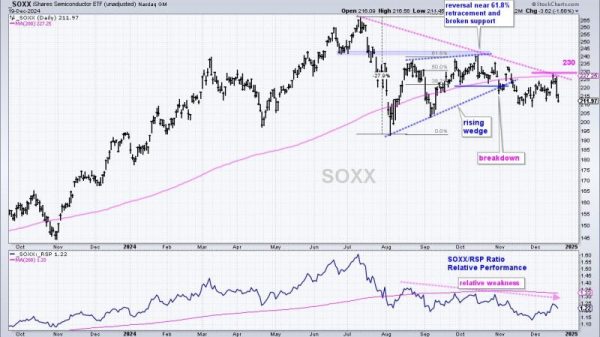The United Nations has designated 2025 as the year of quantum science and technology, highlighting the profound impact that technological advancements are poised to have on the world.
The increasing prevalence of artificial intelligence (AI) across a wide array of industries has spurred significant investment in the sector over the last two years as the world’s largest tech firms jump in. As AI continues to evolve, many investors are wondering if 2025 will be a pivotal year when these investments begin to show significant returns.
How will AI affect the stock market in 2025?
2024 was marked by concerns over the dominance and high valuations of the Magnificent 7, and heading into 2025, investors are keenly watching how these companies will influence the broader stock market.
Citigroup (NYSE:C) analysts have a generally positive outlook for 2025, noting that the Magnificent 7 aren’t trading at unprecedented valuations; rather, the other S&P 500 (INDEXSP:.INX) stocks are at a higher risk.
Essentially, the US stock market is priced for perfection, leaving it susceptible to a correction triggered by rising interest rates, disappointing earnings or a broader economic slowdown.
For its part, BNY asserts that the Magnificent 7 may actually be undervalued relative to their future growth potential. While acknowledging the record-high profit margins in the tech sector, the firm contends that valuations relative to the rest of the market are cheaper than during similar periods of technological advancement in history.
Further, the expectation of continued profit margin expansion and earnings growth fueled by ongoing AI innovation supports the notion of further upside potential for tech stocks.
AI juggernaut NVIDIA’s (NASDAQ:NVDA) sustained profitability underscores its dominant market position and ability to efficiently capitalize on the surging demand for its products.
Goldman Sachs (NYSE:GS) analysts believe the Magnificent 7 will continue to outperform the rest of the S&P 500 in 2025, but only by 7 percentage points, the lowest amount in seven years. The firm sees various elements, including macro factors like US growth and trade policy, favoring the ‘S&P 493.’
David Rosenberg, founder of independent research firm Rosenberg Research and Associates, expressed to the Globe and Mail on December 5 that he has shifted his perspective on the US stock market.
Rather than focusing on reasons for its overvaluation and bearish indicators, he aims to understand the underlying factors driving the market’s behavior over the past two years.
“The market is telling us that we are in a ‘Model Shift’ when it comes to future growth and profits,” he explained. “Traditional valuation methods, like price-to-earnings ratios, are backward-looking and may not be suitable in this environment. Investors are focused on long-term potential, particularly in areas like AI, and are willing to pay a premium for it. The current surge in AI might resemble the dot-com bubble, but it could take years to confirm.’
He added that interest rate cuts from the US Federal Reserve would support higher valuations.
BNY also points to historical data showing that an environment of easing monetary policy tends to coincide with economic growth, with an average of 16.5 percent growth in the year following initial rate cuts since 1984. It suggests that S&P 500 earnings growth will be between 10 to 15 percent in 2025, with the index reaching around 6,600 in 2025. Although this represents slower growth compared to 2024, it still indicates continued expansion.
While Rosenberg is mindful of near-term risks, such as weakness in the US labor market and the likelihood of profit-taking and early rebalancing, he emphasized the importance of keeping an open mind in 2025.
In his view, it’s key for investors to learn from the mistakes of the past year, such as overreacting to short-term volatility and underestimating the potential of transformative technologies.
Profitability in focus as AI improvement rate slows
While Big Tech pours billions into AI development, the question of profitability in 2025 hangs in the balance.
Google (NASDAQ:GOOGL) is prioritizing long-term AI dominance over short-term gains. The company’s aggressive AI spending is expected to continue in 2025, potentially impacting immediate revenue growth.
Similarly, Meta (NASDAQ:META) is heavily investing in AI, with a projected US$1 billion increase in capital expenditures for 2024. CFO Susan Li acknowledged in the company’s earnings call for Q3 of this year that both depreciation and operating expenses will grow next year as Meta expands its AI infrastructure and product line.
Overall, the AI landscape in 2025 hinges significantly on whether Big Tech can deliver on its ambitious promises, and recent commentary suggests that the rate of AI improvement may be slowing down. Several AI investors, founders and CEOs told TechCrunch in November that the focus may shift to efficiency and specialized AI solutions.
Test-time compute, which gives AI models more time to “think” before answering a question, emerged as part of the new era of scaling laws toward the end of 2024. Scaling laws are described by TechCrunch as the methods and expectations that labs have used to increase the capabilities of their models.
This development has fueled a growing belief — held by experts like Anthropic CEO Dario Amodei and OpenAI CEO Sam Altman — that artificial general intelligence (AGI) may be closer than previously anticipated.
Beyond the evolution of scaling laws, Konstantine Buhler of Sequoia Capital told Bloomberg News that 2025 is poised to be a breakout year for AI agents. These sophisticated programs, capable of independently performing tasks and making decisions, have the potential to revolutionize how we interact with technology and automate complex processes.
While the transformative potential of AI spans countless industries, the scale and timing of substantial returns remain uncertain as we navigate this uncharted technological territory.
AI hardware and infrastructure developments to watch
Regardless of the exact timeline or nature of AGI’s arrival, one thing is certain: the race to develop and deploy advanced AI is driving an insatiable demand for powerful hardware, and key companies are stepping up.
“While the mega-cap cloud companies will capture a lot of future revenue opportunities for AI, they are still in spending mode right now. They’re spending heavily on semiconductors, data center infrastructure, and energy,” Nicholas Mersch, associate portfolio manager at Purpose Investments, wrote in a July market commentary note.
The buildout is ongoing, and Big Tech’s latest round of quarterly reports indicates no immediate slowdown in infrastructure spending. This dynamic positions key hardware players like Taiwan Semiconductor Manufacturing Company (NYSE:TSM), NVIDIA and Broadcom (NASDAQ:AVGO) for potentially stronger near-term returns.
For its part, Goldman Sachs predicts that investor focus will now shift from AI infrastructure to a wider “Phase 3” of AI application deployment and monetization. Companies of interest include software and services firms.
Lux Research highlights two primary models: the monopoly model and the ‘walled garden’ approach.
Companies like NVIDIA, Meta and Microsoft are pursuing a monopoly strategy, aiming to capture a large market share and maximize value extraction from a broad user base. Challenges include competition and pressure to keep prices low.
Companies can also adopt a ‘walled garden’ approach, similar to Apple’s (NASDAQ:AAPL) ecosystem, which prioritizes a smaller, more engaged user base. By providing premium features and exclusive content, companies can increase value generated per user. This model may face challenges in achieving the same level of scale as the monopoly model.
Investor takeaway
The outlook for the tech sector and the broader stock market in 2025 is cautiously optimistic.
AI is expected to continue playing a pivotal role, with the race for AI dominance fueling investments in infrastructure and innovation, and positioning key hardware and software players for potential gains.
However, the profitability of AI investments remains to be seen. Companies’ ability to adapt and capitalize on emerging opportunities will be crucial for sustained success in the dynamic landscape of 2025.
Securities Disclosure: I, Meagen Seatter, hold no direct investment interest in any company mentioned in this article.
























